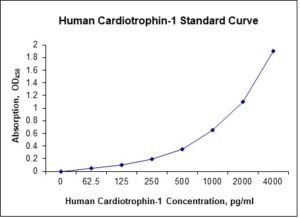Nori Human Cardiotrophin-1 ELISA Kit
$508.00 – $916.00
This ELISA kit is for quantification of CT-1 in human. This is a quick ELISA assay that reduces time to 50% compared to the conventional method, and the entire assay only takes 3 hours. This assay employs the quantitative sandwich enzyme immunoassay technique and uses biotin-streptavidin chemistry to improve the performance of the assays. An antibody specific for CT-1 has been pre-coated onto a microplate. Standards and samples are pipetted into the wells and any CT-1 present is bound by the immobilized antibody. After washing away any unbound substances, a detection antibody specific for CT-1 is added to the wells. Following wash to remove any unbound antibody reagent, a detection reagent is added. After intensive wash a substrate solution is added to the wells and color develops in proportion to the amount of CT-1 bound in the initial step. The color development is stopped, and the intensity of the color is measured.
Alternative names for cardiotrophin-1: CT-1, CTF1
This product is for Laboratory Research Use Only not for diagnostic and therapeutic purposes or any other purposes.
- Description
- How Elisa Works
- Product Citation (0)
- Reviews (0)
Description
Nori Human Cardiotrophin-1 ELISA Kit Summary
Alternative names for cardiotrophin-1: CT-1, CTF1
| Assay Type | Solid Phase Sandwich ELISA |
| Format | 96-well Microplate or 96-Well Strip Microplate |
| Method of Detection | Colorimetric |
| Number of Targets Detected | 1 |
| Target Antigen Accession Number | Q16619 |
| Assay Length | 3 hours |
| Quantitative/Semiquantitative | Quantitative |
| Sample Type | Plasma, Serum, Cell Culture, Urine, Cell/Tissue Lysates, Synovial Fluid, BAL, |
| Recommended Sample Dilution (Plasma/Serum) | No dilution for sample <ULOQ; sufficient dilution for samples >ULOQ |
| Sensitivity | 12 pg/mL |
| Detection Range | 62.5-4000 Pg/mL |
| Specificity | Human CT-1 |
| Cross-Reactivity | < 0.5% cross-reactivity observed with available related molecules, < 50% cross-species reactivity observed with species tested. |
| Interference | No significant interference observed with available related molecules |
| Storage/Stability | 4 ºC for up to 6 months |
| Usage | For Laboratory Research Use Only. Not for diagnostic or therapeutic use. |
| Additional Notes | The kit allows for use in multiple experiments. |
Standard Curve
Kit Components
1. Pre-coated 96-well Microplate
2. Biotinylated Detection Antibody
3. Streptavidin-HRP Conjugate
4. Lyophilized Standards
5. TMB One-Step Substrate
6. Stop Solution
7. 20 x PBS
8. Assay Buffer
Other Materials Required but not Provided:
1. Microplate Reader capable of measuring absorption at 450 nm
2. Log-log graph paper or computer and software for ELISA data analysis
3. Precision pipettes (1-1000 µl)
4. Multi-channel pipettes (300 µl)
5. Distilled or deionized water
Protocol Outline
1. Prepare all reagents, samples and standards as instructed in the datasheet.
2. Add 100 µl of Standard or samples to each well and incubate 1 h at RT.
3. Add 100 µl of Working Detection Antibody to each well and incubate 1 h at RT.
4. Add 100 µl of Working Streptavidin-HRP to each well and incubate 20 min at RT.
5. Add 100 µl of Substrate to each well and incubate 5-30 min at RT.
6. Add 50 µl of Stop Solution to each well and read at 450 nm immediately.
Background:
Cardiotrophin-1 (CT-1) is a cytokine and a cardiac hypertrophic factor of 21.5 kDa and a protein member of the IL-6 cytokine family.[1] CT-1 is associated with the pathophysiology of heart diseases, including hypertension, myocardial infarction, valvular heart disease, and congestive heart failure.[2] The protein exerts its cellular effects by interacting with the glycoprotein 130 (gp130)/leukemia inhibitory factor receptor beta (LIFR) heterodimer.[2] In addition, CT-1 activates phosphatidylinositol 3-kinase in cardiac myocytes and enhances transcription factor NF-κB DNA -binding activities. CT-1 is highly expressed in the heart, skeletal muscle, prostate and ovary and to lower levels in lung, kidney, pancreas, thymus, testis and small intestine. Non-diabetic subjects who were overweight or obesity had significantly lower cardiotrophin-1 concentrations than those with normal weight, and both obesity and being overweight were inversely associated with cardiotrophin-1 levels.[4] A transcriptional factor, Myc-associated zinc finger protein (MAZ), plays an important role in ADAM10 transcription in response to CT-1 in neural stem/progenitor cells.[5] Cardiotrophin-1 levels were not an independent predictor of all-cause mortality in hemodialysis patients.[6] The cytokine cardiotrophin 1 (CT1) acts as a factor capable of recapitulating the key features of physiologic growth of the heart including transient and reversible hypertrophy of the myocardium, and stimulation of cardiomyocyte-derived angiogenic signals leading to increased vascularity.[7] In children with pediatric obesity, lifestyle weight-loss intervention results in down-regulation of serum cardiotrophin-1 (CTF1), interleukin-6 (IL6), and tumor necrosis factor-alpha (TNFA); expression of CTF1, IL6, and TNFA is also down-regulated in peripheral blood mononuclear cells after improvement in adiposity, body mass index, and waist-hip ratio.[8]
References
- Pennica D, et al. (1995) Proc. Natl. Acad. Sci. U.S.A. 92 (4), 1142-1146.
- Erdmann J, et al. (2000) Hum. Mutat. 16 (5), 448.
- Pennica D, et al. (1995) J. Biol. Chem. 270 (18), 10915-10922.
- Hung HC, et al. (2015) Sci Rep 5, 17438.
- Liu B, et al. (2016) Sci Rep 6, 21534.
- Hogas S, et al. (2016) Angiology 67 (9), 854-859.
- Abdul-Ghani M, et al. (2017) Cell Res. 27 (10), 1195-1215.
- Marti A, et al. (2018) Pediatr Diabetes 19 (2), 217-222.
Be the first to review “Nori Human Cardiotrophin-1 ELISA Kit”
You must be logged in to post a review.




























Reviews
There are no reviews yet.